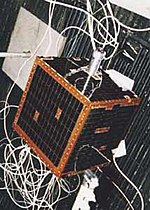 SEDSAT-1 satellite. | |
| Mission type | Communications |
|---|---|
| Operator | AMSAT |
| COSPAR ID | 1998-061B |
| SATCAT no. | 25509 |
| Spacecraft properties | |
| Manufacturer | University of Alabama |
| Launch mass | 35 kg (77 lb) |
| Dimensions | 32.13 cm × 32.13 cm × 35.43 cm (12.65 in × 12.65 in × 13.95 in)[1] |
| Start of mission | |
| Launch date | 24 October 1998, 12:08 UTC |
| Rocket | Delta-7326 D-261 |
| Launch site | Cape Canaveral SLC-17A |
| Orbital parameters | |
| Reference system | Geocentric |
| Regime | Low Earth |
| Eccentricity | 0.03699 |
| Perigee altitude | 547 kilometres (340 mi) |
| Apogee altitude | 1,079 kilometres (670 mi) |
| Inclination | 31.4° |
| Period | 101 minutes |
| Epoch | 24 October 1998[2] |
SEDSAT-1 (also known as SEDSAT-OSCAR 33) is a U.S. amateur radio satellite built by students and developed at the University of Alabama in Huntsville (UAH).
The microsatellite bears the name of one of its sponsoring organizations, the Students for the Exploration and Development of Space (SEDS). It was launched into a low Earth orbit on October 24, 1998 as a Secondary payload with the Deep Space 1 spacecraft using a Delta II rocket at Cape Canaveral Air Force Station, Florida, USA.
- ^ Gunter Dirk Krebs. "SEDSat 1 (SO 33, SEDSat-OSCAR 33)". Gunter's Space Page. Retrieved 10 February 2020.
- ^ NASA GSFC. "Telemetry Details". NSSDCA Master Catalog. Retrieved 10 February 2020.